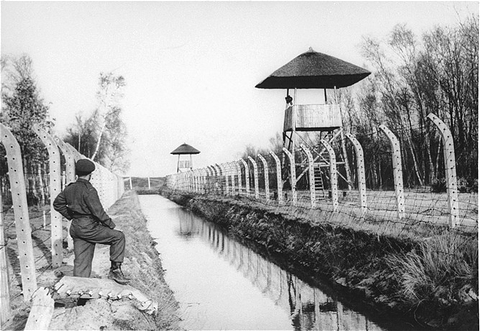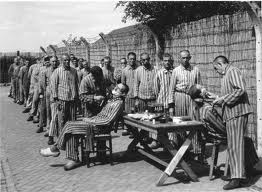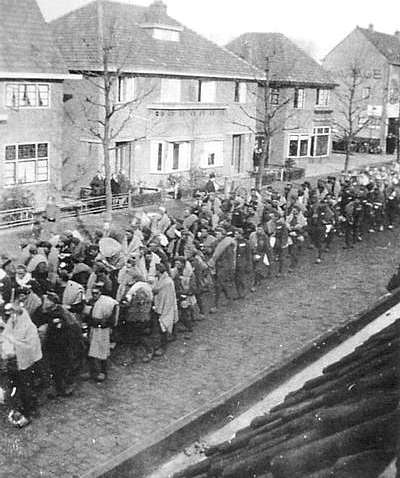The children transport from Vught concentration camp to Sobibor.

A camp for Dutch political prisoners was established at Vught, near the city in southern Holland near the city of Hertogenbosch, capital of the Noord-Brabant province and close to my hometown Eindhoven. In September 1944 Eindhoven was liberated by the 101 AB  “Screaming Eagles”, the “Band of Brothers” during Operation Market Garden.
“Screaming Eagles”, the “Band of Brothers” during Operation Market Garden.

 The camp was taken over by the WVHA in late 1942 and was re-designated Konzentrationlager Herzogenbusch, which now housed political prisoners and Jews, held in transit awaiting the deportations to Poland. WVHA is the SS-Wirtschafts-Verwaltungshauptamt, the Economic and Administrative Main Office of the Nazi SS.
The camp was taken over by the WVHA in late 1942 and was re-designated Konzentrationlager Herzogenbusch, which now housed political prisoners and Jews, held in transit awaiting the deportations to Poland. WVHA is the SS-Wirtschafts-Verwaltungshauptamt, the Economic and Administrative Main Office of the Nazi SS.
Karl Chmielewski  who had served at several concentration camps such as Columbia Haus, Sachenhausen, Mauthausen / Gusen was appointed camp commandant in 1943 and on his appointment brought with 80 Kapos with him. Vught however, was not as brutal as these concentration camps, there were strict regulations regarding the treatment of inmates, experience in the second concentration camp in the Netherlands, Westerbork had shown that deportations proceeded more smoothly if cruelty was avoided. Having disappeared in Austria after the war, Karl Chmielewski was not tried until 1961, although he would receive a life sentence of hard labour when he was. The trial pronounced him a sadist who took pleasure in killing prisoners, whom he did not see as human, by scalding them with boiling water. He was ultimately found guilty of causing the deaths of prisoners through his brutality. He was eventually released in March 1979 on mental health grounds and spent his last years in a care institution at Bernau at the Chiemsee, He died old age 88 on 01-012-1991.
who had served at several concentration camps such as Columbia Haus, Sachenhausen, Mauthausen / Gusen was appointed camp commandant in 1943 and on his appointment brought with 80 Kapos with him. Vught however, was not as brutal as these concentration camps, there were strict regulations regarding the treatment of inmates, experience in the second concentration camp in the Netherlands, Westerbork had shown that deportations proceeded more smoothly if cruelty was avoided. Having disappeared in Austria after the war, Karl Chmielewski was not tried until 1961, although he would receive a life sentence of hard labour when he was. The trial pronounced him a sadist who took pleasure in killing prisoners, whom he did not see as human, by scalding them with boiling water. He was ultimately found guilty of causing the deaths of prisoners through his brutality. He was eventually released in March 1979 on mental health grounds and spent his last years in a care institution at Bernau at the Chiemsee, He died old age 88 on 01-012-1991.
The camp measured 500 by 200 meters and consisted of thirty –six living and twenty-three working barracks. A double barbed-wire fence with a ditch between them surrounded the camp. Watchtowers were placed every 50 meters around the perimeter, situated outside the camp boundaries were the SS living quarters, an execution area  and an industrial plant owned by the electrical giant Philips.
and an industrial plant owned by the electrical giant Philips.
The first Jewish prisoners arrived in Vught during January 1943 and by May 1943 their numbers had increased to 8,684, conditions in the camp were very poor although some improvement occurred following a visit by David Cohen  a member of the Jewish Council (Joodsche Raad). Cohen survived concentration camp Theresienstadt and died old age 84 on 03-09-1967 in Amsterdam.
a member of the Jewish Council (Joodsche Raad). Cohen survived concentration camp Theresienstadt and died old age 84 on 03-09-1967 in Amsterdam.
From April 1943, a number of male prisoners were sent to work outside the camp, although most inmates were employed within the camp manufacturing clothing and furs. The most sought after employment was in the Philips Company where 1,200 prisoners were employed.
The Philips Company insisted that its Jewish workers should enjoy decent conditions, including a cooked meal every day and to be spared from deportation. Dr Arthur Lehmann was appointed head of the Jewish administration in the camp during October 1943 he did his best to care for the inmates and was very popular with them.
For a time religious and cultural activities had been permitted and a school had functioned, but this all changed for the worse with the appointment of Adam Grunewald i n October 1943, who like his predecessor had served at a number of concentration camps including Lichtenburg, Dachau, Buchenwald and Sachenhausen.
Grunewald  was a brutal commandant and he was removed for excessive ill-treatment of the prisoners to be replaced by Hans Huettig
was a brutal commandant and he was removed for excessive ill-treatment of the prisoners to be replaced by Hans Huettig  in January 1944. Grunewald however like his predecessor he too was tried and found guilty of causing the deaths of prisoners by excess cruelty, in his case for the Bunker Tragedy. He was sentenced to 15 years imprisonment but was then pardoned. He finished the war with the 3rd SS Division Totenkopf and died, age 42 on 22-01-1945, during a German counteroffensive in the siege of Budapest. His final rank was SS Sturmbannführer. Huettig too had followed a similar path with concentration camp service in Lichtenburg, Sachenhausen, Buchenwald, Flossenberg, Natzweiler. After the war Hüttig was in Allied internment. He was sentenced to death on July 2, 1954 by a French military court in Metz, but the death sentence was not enforced. In 1956, he was released from detention after eleven years and led a discreet life at home, until his death on 23-02-1980, old age 85 in Wachenheim.
in January 1944. Grunewald however like his predecessor he too was tried and found guilty of causing the deaths of prisoners by excess cruelty, in his case for the Bunker Tragedy. He was sentenced to 15 years imprisonment but was then pardoned. He finished the war with the 3rd SS Division Totenkopf and died, age 42 on 22-01-1945, during a German counteroffensive in the siege of Budapest. His final rank was SS Sturmbannführer. Huettig too had followed a similar path with concentration camp service in Lichtenburg, Sachenhausen, Buchenwald, Flossenberg, Natzweiler. After the war Hüttig was in Allied internment. He was sentenced to death on July 2, 1954 by a French military court in Metz, but the death sentence was not enforced. In 1956, he was released from detention after eleven years and led a discreet life at home, until his death on 23-02-1980, old age 85 in Wachenheim.
A proclamation was issued by the Vught Kampleidung on 5 June 1943, two transports were to be sent to a “special children’s camp.”
In accordance with the terms of the proclamation, all children up to the age of three were to be accompanied by their mothers and those aged between three and sixteen by one of their parents. The “special children’s camp” was Sobibor death camp in Poland.  The first train, containing 1,750 Jewish people many of them unaccompanied sick children arrived at another transit camp for Jews in Holland – Westerbork on 7 June 1943. The second transport arrived a day later – 1,300 tired, filthy people were transferred amid much snarling, shouting and beatings from the freight cars that had taken them from Vught, to another set of dirty freight cars that would transport them to Sobibor death camp. All 3.050 were gassed the same day of arrival.
The first train, containing 1,750 Jewish people many of them unaccompanied sick children arrived at another transit camp for Jews in Holland – Westerbork on 7 June 1943. The second transport arrived a day later – 1,300 tired, filthy people were transferred amid much snarling, shouting and beatings from the freight cars that had taken them from Vught, to another set of dirty freight cars that would transport them to Sobibor death camp. All 3.050 were gassed the same day of arrival.
With the exception of two transports which went directly from Vught to Auschwitz, all transports from Vught were routed via Westerbork. The first of these transports to concentration camp Westerbork, where Anna Frank  and her family were interred later, left at the end of January 1943, shortly after the transit camp at Vught had been established.
and her family were interred later, left at the end of January 1943, shortly after the transit camp at Vught had been established.
The camp’s population peaked in May 1943 but this steadily declined until 3 June 1944, when the camp was liquidated. The last group to be transported from Vught on 3 June 1944 was made up of 517 Philips’ workers,  the company having failed to save them, but even in Auschwitz this group received preferential treatment, being employed by Telefunken, under an agreement reached between Telefunken and Philips.
the company having failed to save them, but even in Auschwitz this group received preferential treatment, being employed by Telefunken, under an agreement reached between Telefunken and Philips.
Nevertheless, most of the men in this group perished, only 160 survived, two thirds were women and nine were children. Today the former camp is part of the army barracks of the Dutch Royal Engineers and part is a museum.











Leave a Reply